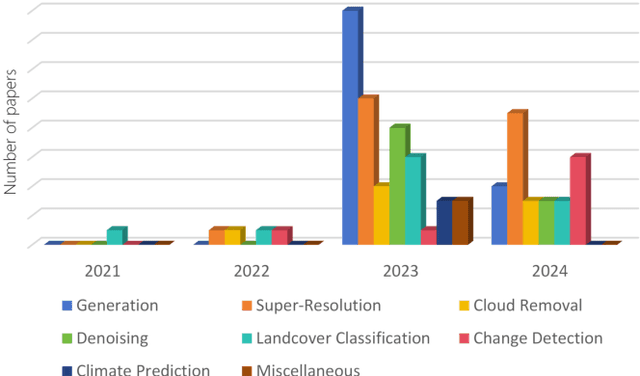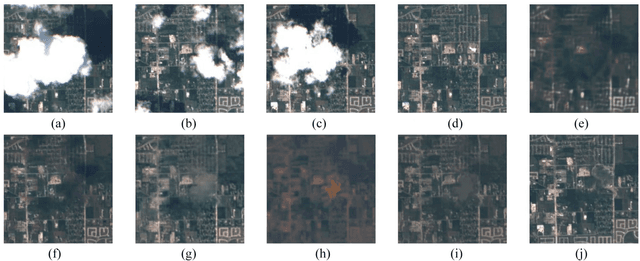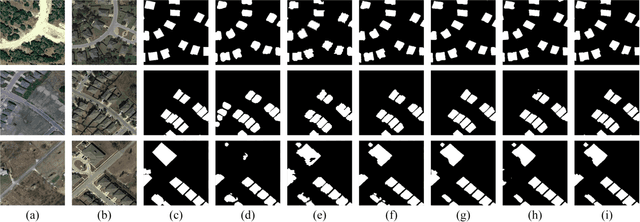Pedram Ghamisi
Sabrina
FlexiMo: A Flexible Remote Sensing Foundation Model
Mar 31, 2025Abstract:The rapid expansion of multi-source satellite imagery drives innovation in Earth observation, opening unprecedented opportunities for Remote Sensing Foundation Models to harness diverse data. However, many existing models remain constrained by fixed spatial resolutions and patch sizes, limiting their ability to fully exploit the heterogeneous spatial characteristics inherent in satellite imagery. To address these challenges, we propose FlexiMo, a flexible remote sensing foundation model that endows the pre-trained model with the flexibility to adapt to arbitrary spatial resolutions. Central to FlexiMo is a spatial resolution-aware module that employs a parameter-free alignment embedding mechanism to dynamically recalibrate patch embeddings based on the input image's resolution and dimensions. This design not only preserves critical token characteristics and ensures multi-scale feature fidelity but also enables efficient feature extraction without requiring modifications to the underlying network architecture. In addition, FlexiMo incorporates a lightweight channel adaptation module that leverages prior spectral information from sensors. This mechanism allows the model to process images with varying numbers of channels while maintaining the data's intrinsic physical properties. Extensive experiments on diverse multimodal, multi-resolution, and multi-scale datasets demonstrate that FlexiMo significantly enhances model generalization and robustness. In particular, our method achieves outstanding performance across a range of downstream tasks, including scene classification, land cover classification, urban building segmentation, and cloud detection. By enabling parameter-efficient and physically consistent adaptation, FlexiMo paves the way for more adaptable and effective foundation models in real-world remote sensing applications.
GeoLangBind: Unifying Earth Observation with Agglomerative Vision-Language Foundation Models
Mar 08, 2025Abstract:Earth observation (EO) data, collected from diverse sensors with varying imaging principles, present significant challenges in creating unified analytical frameworks. We present GeoLangBind, a novel agglomerative vision--language foundation model that bridges the gap between heterogeneous EO data modalities using language as a unifying medium. Our approach aligns different EO data types into a shared language embedding space, enabling seamless integration and complementary feature learning from diverse sensor data. To achieve this, we construct a large-scale multimodal image--text dataset, GeoLangBind-2M, encompassing six data modalities. GeoLangBind leverages this dataset to develop a zero-shot foundation model capable of processing arbitrary numbers of EO data channels as input. Through our designed Modality-aware Knowledge Agglomeration (MaKA) module and progressive multimodal weight merging strategy, we create a powerful agglomerative foundation model that excels in both zero-shot vision--language comprehension and fine-grained visual understanding. Extensive evaluation across 23 datasets covering multiple tasks demonstrates GeoLangBind's superior performance and versatility in EO applications, offering a robust framework for various environmental monitoring and analysis tasks. The dataset and pretrained models will be publicly available.
Change Captioning in Remote Sensing: Evolution to SAT-Cap -- A Single-Stage Transformer Approach
Jan 14, 2025Abstract:Change captioning has become essential for accurately describing changes in multi-temporal remote sensing data, providing an intuitive way to monitor Earth's dynamics through natural language. However, existing change captioning methods face two key challenges: high computational demands due to multistage fusion strategy, and insufficient detail in object descriptions due to limited semantic extraction from individual images. To solve these challenges, we propose SAT-Cap based on the transformers model with a single-stage feature fusion for remote sensing change captioning. In particular, SAT-Cap integrates a Spatial-Channel Attention Encoder, a Difference-Guided Fusion module, and a Caption Decoder. Compared to typical models that require multi-stage fusion in transformer encoder and fusion module, SAT-Cap uses only a simple cosine similarity-based fusion module for information integration, reducing the complexity of the model architecture. By jointly modeling spatial and channel information in Spatial-Channel Attention Encoder, our approach significantly enhances the model's ability to extract semantic information from objects in multi-temporal remote sensing images. Extensive experiments validate the effectiveness of SAT-Cap, achieving CIDEr scores of 140.23% on the LEVIR-CC dataset and 97.74% on the DUBAI-CC dataset, surpassing current state-of-the-art methods. The code and pre-trained models will be available online.
ChangeMinds: Multi-task Framework for Detecting and Describing Changes in Remote Sensing
Oct 15, 2024



Abstract:Recent advancements in Remote Sensing (RS) for Change Detection (CD) and Change Captioning (CC) have seen substantial success by adopting deep learning techniques. Despite these advances, existing methods often handle CD and CC tasks independently, leading to inefficiencies from the absence of synergistic processing. In this paper, we present ChangeMinds, a novel unified multi-task framework that concurrently optimizes CD and CC processes within a single, end-to-end model. We propose the change-aware long short-term memory module (ChangeLSTM) to effectively capture complex spatiotemporal dynamics from extracted bi-temporal deep features, enabling the generation of universal change-aware representations that effectively serve both CC and CD tasks. Furthermore, we introduce a multi-task predictor with a cross-attention mechanism that enhances the interaction between image and text features, promoting efficient simultaneous learning and processing for both tasks. Extensive evaluations on the LEVIR-MCI dataset, alongside other standard benchmarks, show that ChangeMinds surpasses existing methods in multi-task learning settings and markedly improves performance in individual CD and CC tasks. Codes and pre-trained models will be available online.
MineNetCD: A Benchmark for Global Mining Change Detection on Remote Sensing Imagery
Jul 04, 2024



Abstract:Monitoring changes triggered by mining activities is crucial for industrial controlling, environmental management and regulatory compliance, yet it poses significant challenges due to the vast and often remote locations of mining sites. Remote sensing technologies have increasingly become indispensable to detect and analyze these changes over time. We thus introduce MineNetCD, a comprehensive benchmark designed for global mining change detection using remote sensing imagery. The benchmark comprises three key contributions. First, we establish a global mining change detection dataset featuring more than 70k paired patches of bi-temporal high-resolution remote sensing images and pixel-level annotations from 100 mining sites worldwide. Second, we develop a novel baseline model based on a change-aware Fast Fourier Transform (ChangeFFT) module, which enhances various backbones by leveraging essential spectrum components within features in the frequency domain and capturing the channel-wise correlation of bi-temporal feature differences to learn change-aware representations. Third, we construct a unified change detection (UCD) framework that integrates over 13 advanced change detection models. This framework is designed for streamlined and efficient processing, utilizing the cloud platform hosted by HuggingFace. Extensive experiments have been conducted to demonstrate the superiority of the proposed baseline model compared with 12 state-of-the-art change detection approaches. Empirical studies on modularized backbones comprehensively confirm the efficacy of different representation learners on change detection. This contribution represents significant advancements in the field of remote sensing and change detection, providing a robust resource for future research and applications in global mining monitoring. Dataset and Codes are available via the link.
How to Learn More? Exploring Kolmogorov-Arnold Networks for Hyperspectral Image Classification
Jun 22, 2024



Abstract:Convolutional Neural Networks (CNNs) and vision transformers (ViTs) have shown excellent capability in complex hyperspectral image (HSI) classification. However, these models require a significant number of training data and are computational resources. On the other hand, modern Multi-Layer Perceptrons (MLPs) have demonstrated great classification capability. These modern MLP-based models require significantly less training data compared to CNNs and ViTs, achieving the state-of-the-art classification accuracy. Recently, Kolmogorov-Arnold Networks (KANs) were proposed as viable alternatives for MLPs. Because of their internal similarity to splines and their external similarity to MLPs, KANs are able to optimize learned features with remarkable accuracy in addition to being able to learn new features. Thus, in this study, we assess the effectiveness of KANs for complex HSI data classification. Moreover, to enhance the HSI classification accuracy obtained by the KANs, we develop and propose a Hybrid architecture utilizing 1D, 2D, and 3D KANs. To demonstrate the effectiveness of the proposed KAN architecture, we conducted extensive experiments on three newly created HSI benchmark datasets: QUH-Pingan, QUH-Tangdaowan, and QUH-Qingyun. The results underscored the competitive or better capability of the developed hybrid KAN-based model across these benchmark datasets over several other CNN- and ViT-based algorithms, including 1D-CNN, 2DCNN, 3D CNN, VGG-16, ResNet-50, EfficientNet, RNN, and ViT. The code are publicly available at (https://github.com/aj1365/HSIConvKAN)
HDMba: Hyperspectral Remote Sensing Imagery Dehazing with State Space Model
Jun 09, 2024



Abstract:Haze contamination in hyperspectral remote sensing images (HSI) can lead to spatial visibility degradation and spectral distortion. Haze in HSI exhibits spatial irregularity and inhomogeneous spectral distribution, with few dehazing networks available. Current CNN and Transformer-based dehazing methods fail to balance global scene recovery, local detail retention, and computational efficiency. Inspired by the ability of Mamba to model long-range dependencies with linear complexity, we explore its potential for HSI dehazing and propose the first HSI Dehazing Mamba (HDMba) network. Specifically, we design a novel window selective scan module (WSSM) that captures local dependencies within windows and global correlations between windows by partitioning them. This approach improves the ability of conventional Mamba in local feature extraction. By modeling the local and global spectral-spatial information flow, we achieve a comprehensive analysis of hazy regions. The DehazeMamba layer (DML), constructed by WSSM, and residual DehazeMamba (RDM) blocks, composed of DMLs, are the core components of the HDMba framework. These components effectively characterize the complex distribution of haze in HSIs, aiding in scene reconstruction and dehazing. Experimental results on the Gaofen-5 HSI dataset demonstrate that HDMba outperforms other state-of-the-art methods in dehazing performance. The code will be available at https://github.com/RsAI-lab/HDMba.
Responsible AI for Earth Observation
May 31, 2024Abstract:The convergence of artificial intelligence (AI) and Earth observation (EO) technologies has brought geoscience and remote sensing into an era of unparalleled capabilities. AI's transformative impact on data analysis, particularly derived from EO platforms, holds great promise in addressing global challenges such as environmental monitoring, disaster response and climate change analysis. However, the rapid integration of AI necessitates a careful examination of the responsible dimensions inherent in its application within these domains. In this paper, we represent a pioneering effort to systematically define the intersection of AI and EO, with a central focus on responsible AI practices. Specifically, we identify several critical components guiding this exploration from both academia and industry perspectives within the EO field: AI and EO for social good, mitigating unfair biases, AI security in EO, geo-privacy and privacy-preserving measures, as well as maintaining scientific excellence, open data, and guiding AI usage based on ethical principles. Furthermore, the paper explores potential opportunities and emerging trends, providing valuable insights for future research endeavors.
MaskCD: A Remote Sensing Change Detection Network Based on Mask Classification
Apr 18, 2024



Abstract:Change detection (CD) from remote sensing (RS) images using deep learning has been widely investigated in the literature. It is typically regarded as a pixel-wise labeling task that aims to classify each pixel as changed or unchanged. Although per-pixel classification networks in encoder-decoder structures have shown dominance, they still suffer from imprecise boundaries and incomplete object delineation at various scenes. For high-resolution RS images, partly or totally changed objects are more worthy of attention rather than a single pixel. Therefore, we revisit the CD task from the mask prediction and classification perspective and propose MaskCD to detect changed areas by adaptively generating categorized masks from input image pairs. Specifically, it utilizes a cross-level change representation perceiver (CLCRP) to learn multiscale change-aware representations and capture spatiotemporal relations from encoded features by exploiting deformable multihead self-attention (DeformMHSA). Subsequently, a masked-attention-based detection transformers (MA-DETR) decoder is developed to accurately locate and identify changed objects based on masked attention and self-attention mechanisms. It reconstructs the desired changed objects by decoding the pixel-wise representations into learnable mask proposals and making final predictions from these candidates. Experimental results on five benchmark datasets demonstrate the proposed approach outperforms other state-of-the-art models. Codes and pretrained models are available online (https://github.com/EricYu97/MaskCD).
Diffusion Models Meet Remote Sensing: Principles, Methods, and Perspectives
Apr 13, 2024



Abstract:As a newly emerging advance in deep generative models, diffusion models have achieved state-of-the-art results in many fields, including computer vision, natural language processing, and molecule design. The remote sensing community has also noticed the powerful ability of diffusion models and quickly applied them to a variety of tasks for image processing. Given the rapid increase in research on diffusion models in the field of remote sensing, it is necessary to conduct a comprehensive review of existing diffusion model-based remote sensing papers, to help researchers recognize the potential of diffusion models and provide some directions for further exploration. Specifically, this paper first introduces the theoretical background of diffusion models, and then systematically reviews the applications of diffusion models in remote sensing, including image generation, enhancement, and interpretation. Finally, the limitations of existing remote sensing diffusion models and worthy research directions for further exploration are discussed and summarized.
 Add to Chrome
Add to Chrome Add to Firefox
Add to Firefox Add to Edge
Add to Edge